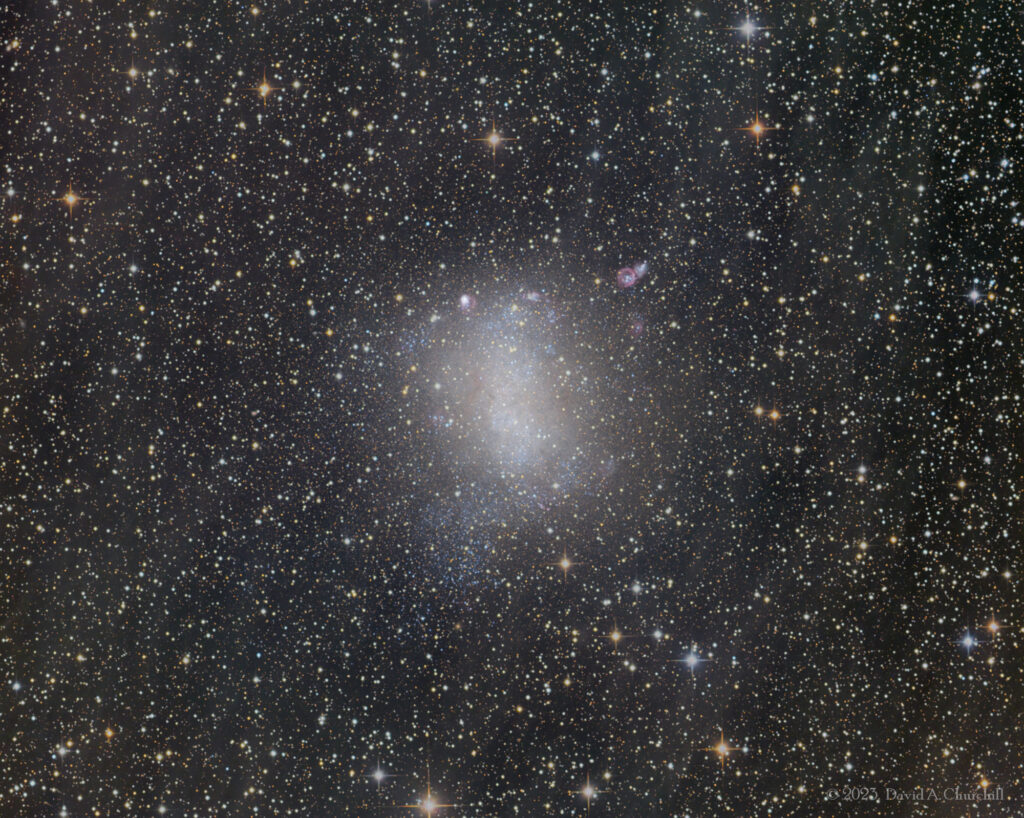NGC 6822 (Caldwell 57)
Barnard's Galaxy. Barred Irregular Galaxy, Sagittarius
- Description
- Technical
- Links
NGC 6822 (also known as Barnard’s Galaxy, IC 4895, or Caldwell 57) is a barred irregular galaxy approximately 1.6 million light-years away in the constellation Sagittarius. Part of the Local Group of galaxies, it was discovered by E. E. Barnard in 1884, with a six-inch refractor telescope. It is the closest non-satellite galaxy to the Milky Way, but lies just outside its virial radius. It is similar in structure and composition to the Small Magellanic Cloud. It is about 7,000 light-years in diameter.
Edwin Hubble, in the paper N.G.C. 6822, A Remote Stellar System, identified 15 variable stars (11 of which were Cepheids) of this galaxy. He also surveyed the galaxy’s stars distribution down to magnitude 19.4. He provided spectral characteristics, luminosities and dimensions for the five brightest “diffuse nebulae” (giant H II regions) that included the Bubble Nebula and the Ring Nebula. He also computed the absolute magnitude of the entire galaxy. Hubble’s detection of eleven Cepheid variable stars was a milestone in astronomy. Utilizing the Cepheid Period-Luminosity relationship, Hubble determined a distance of 214 kiloparsecs or 698,000 light-years. This was the first system beyond the Magellanic Clouds to have its distance determined. (Hubble continued this process with the Andromeda Galaxy and the Triangulum Galaxy). His distance to the galaxy was way beyond Harlow Shapley’s value of 300,000 light-years for the size of the universe. In the paper, Hubble concluded the “Great Debate” of 1920 between Heber Curtis and Shapley over the scale of the universe and the nature of the “spiral nebula”. It soon became evident that all spiral nebulae were in fact spiral galaxies far outside our own Milky Way.
Observations of the galaxy show stars-forming in the dense cores of giant clouds of molecular hydrogen gas, cold enough to collapse under its own gravity. The distribution of hydrogen gas is disk-shaped, but mysteriously, it is angled at about 60° relative to the stellar distribution. Most of its stars formed within the last 3 to 5 billion years. NGC 6822 has spent most of its life in relative isolation. However, it likely passed within the virial radius of the Milky Way some 3 to 4 billion years ago, which may be coincident with its increase in star formation.
Edwin Hubble, in the paper N.G.C. 6822, A Remote Stellar System, identified 15 variable stars (11 of which were Cepheids) of this galaxy. He also surveyed the galaxy’s stars distribution down to magnitude 19.4. He provided spectral characteristics, luminosities and dimensions for the five brightest “diffuse nebulae” (giant H II regions) that included the Bubble Nebula and the Ring Nebula. He also computed the absolute magnitude of the entire galaxy. Hubble’s detection of eleven Cepheid variable stars was a milestone in astronomy. Utilizing the Cepheid Period-Luminosity relationship, Hubble determined a distance of 214 kiloparsecs or 698,000 light-years. This was the first system beyond the Magellanic Clouds to have its distance determined. (Hubble continued this process with the Andromeda Galaxy and the Triangulum Galaxy). His distance to the galaxy was way beyond Harlow Shapley’s value of 300,000 light-years for the size of the universe. In the paper, Hubble concluded the “Great Debate” of 1920 between Heber Curtis and Shapley over the scale of the universe and the nature of the “spiral nebula”. It soon became evident that all spiral nebulae were in fact spiral galaxies far outside our own Milky Way.
Observations of the galaxy show stars-forming in the dense cores of giant clouds of molecular hydrogen gas, cold enough to collapse under its own gravity. The distribution of hydrogen gas is disk-shaped, but mysteriously, it is angled at about 60° relative to the stellar distribution. Most of its stars formed within the last 3 to 5 billion years. NGC 6822 has spent most of its life in relative isolation. However, it likely passed within the virial radius of the Milky Way some 3 to 4 billion years ago, which may be coincident with its increase in star formation.
Telescope: Planewave CDK17 (FR) f4.5
Mount: Astro Physics 1600GTO
Camera: QHY16200A/ Integral FW
Guider: Agena Starguide II / ZWO ASI178MM
Filters: Astronomik 36mm LRGB
L: 32×10 mins = 320 mins, R: 24×10 mins = 240 mins, G: 24×10 mins = 240 mins, B: 23×10 mins = 230 mins
Total Imaging Time: 17h 10m
Data Imaged remotely over 4 nights during August 2023.
Imaged from Observatorio El Sauce, Chile, in partnership with Fred Espenak.
Data acquisition & Processing by David Churchill.
None

